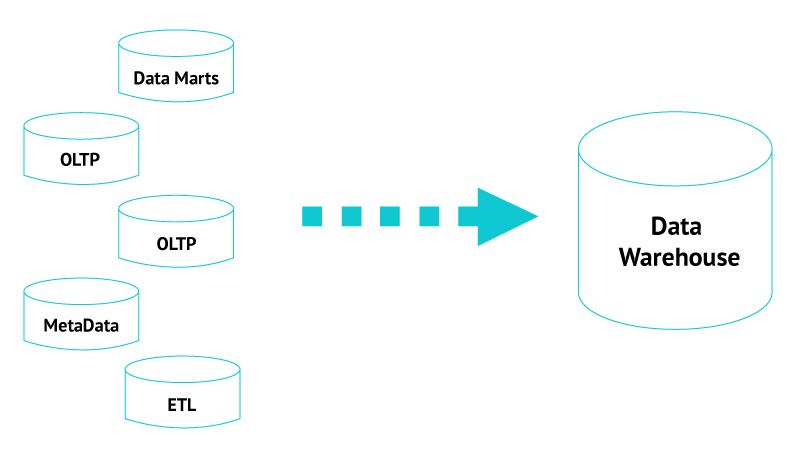Data Warehousing: A Comprehensive Guide from Strategy to Implementation

In the age of data-driven decision-making, the value of streamlined and accessible information cannot be overstated. If you find yourself juggling fragmented spreadsheets and disjointed databases, struggling with data inconsistencies and access limitations, it’s time to explore a solution that can transform how you handle data.
In this blog, we seek to unveil the power of data warehousing and its potential to reshape your data management practices.
What is Data Warehouse?
Imagine your company as a giant puzzle, where every department generates pieces of information. These pieces, like spreadsheets, databases, and software systems, are scattered in different places. The data warehouse is like the master puzzle board that combines all these pieces.
A data warehouse is a specialized database designed to hold huge amounts of information from various sources. It’s not just about storage; it’s about organization and accessibility.
Think of it as a super-efficient librarian. It collects, sorts, and arranges data from sales, customers, products, and more. This arrangement isn’t random—it’s structured to make it easy to find and analyze.
But wait, there’s more! A data warehouse doesn’t just sit there; it’s actively making your company more innovative. It uses tools and techniques to help you discover patterns, trends, and insights. It’s like a data scientist who looks at all the puzzle pieces and tells you what the big picture looks like.
In short, a data warehouse is the tech-savvy brain of your company. It collects, organizes, and interprets data, giving you the tools to make informed decisions and see the bigger picture.
Read more: Analytics on Cloud – Trends Enterprise CIOs Must Have an Eye on in 2023
What are the Benefits of a Data Warehouse
- Unlock Data-Driven Capabilities: Embrace data-driven decision-making by centralizing information through a data warehouse, eliminating silos, and facilitating confident choices based on recent data.
- Use Data from Numerous Sources: Combine data from various departments within the organization, ensuring holistic insights and minimizing inconsistencies that compromise decision-making.
- Realize The Power of Automation: Leverage data warehousing to experiment with automation, streamlining workflows, automating data analysis, error detection, and more, improving efficiency and accuracy.
- Maintain Data Quality and Consistency: Enhance data quality by removing duplicates, standardizing formats, and ensuring consistency, making the data warehouse a reliable source for accurate insights.
- Get Data Warehousing on a Subscription Model: Overcome upfront costs by adopting data warehousing-as-a-service, accessing data over the internet through subscription models offered by top companies like Snowflake, IBM, Google, and Microsoft.
- Respond To Business Growth: Utilize historical data within a data warehouse to understand growth patterns, assess the success factors, and make informed decisions during expansion or changes.
- Enjoy Interoperability Between Physical Solutions and The Cloud: Seamlessly integrate data between physical solutions and cloud-based platforms, catering to various infrastructural needs and remote access requirements.
- Learn More About Your Customers: Personalize customer experiences by using data warehouse insights to understand pain points, behaviors, and preferences and provide tailored recommendations.
- Study Historical Overviews of Business Activities: Access historical data through queries, enabling executives to understand how the organization has evolved and make more accurate predictions for the future.
- Retain The Security of Your Data: Improve data security by consolidating information in one location, enhancing visibility, and utilizing built-in security features to protect against cyber threats.
What is Modern Data Warehouse
A modern data warehouse represents a transformative cloud-based solution that aggregates and houses valuable information. Within this advanced framework, organizations can harness the power of data processing to derive intelligent insights, thereby driving informed decision-making across various sectors. This progressive approach is widely adopted by organizations seeking to enhance financial strategies, optimize human resources, and streamline operational workflows. The pivotal role of a quality cloud-based warehouse empowers departments to elevate decision-making processes, yielding more innovative and more impactful outcomes.
Data Warehouse Implementation
Data Warehouse Implementation is a comprehensive process that transforms the vision of a fully functioning Data Warehouse into reality. This journey involves a series of strategically planned activities, from classifying and analyzing data to designing the Data Warehouse architecture, all while aligning with the specific requirements provided by the client. The successful implementation of a Data Warehouse is essential for organizations to unlock the power of data-driven decision-making and business intelligence.

Data Warehouse Implementation
Source: Educba
The Phases of Data Warehouse Implementation:
- Planning: The foundation of any successful project lies in effective planning. This step establishes the roadmap for the entire project. Proper planning ensures that goals, objectives, and resources are aligned, minimizing the risk of failure.
- Data Gathering: This phase collects data from various relevant sources to the organization’s operations. However, not all data is valuable. Data gathering involves identifying and collecting data that is useful for data analysis and reporting purposes. It is a meticulous and time-consuming process that forms the basis of the Data Warehouse.
- Data Analysis: Once the data is collected, the next step is to analyze it to extract meaningful insights. Data analysis involves processing and transforming raw data into actionable information. This process enables organizations to make informed decisions based on data-driven insights.
- Business Actions: The insights derived from data analysis fuel making informed business decisions. This phase involves utilizing the insights to strategize and take actions that align with the organization’s goals. Effective business actions ensure that the organization benefits from the information gathered and analyzed.
Key Components of Data Warehouse Implementation
- Data Marts: Data Marts are specialized subsets of a Data Warehouse focused on specific business lines or departments. They allow organizations to efficiently store and manage data related to a particular area, such as sales, marketing, or human resources.
- OLTP (Online Transactional Processing): OLTP deals with processing transactional data associated with the day-to-day tasks of an organization. It involves handling frequently changing data, such as customer orders and inventory updates.
- OLAP (Online Analytical Processing): OLAP focuses on processing and analyzing data stored in the database. Unlike OLTP, OLAP deals with master data that is not frequently changing. It supports complex queries and data aggregation for reporting and analysis purposes.
- ETL (Extract, Transform, Load): ETL is the process of extracting data from various sources, transforming it to fit a standardized format, and loading it into the Data Warehouse. ETL tools play a crucial role in the efficiency and accuracy of Data Warehouse Implementation.
- Metadata: Metadata refers to the data about data. It provides information about the context, structure, and relationships of the stored data. Metadata aids in data governance, data lineage, and maintaining data quality.
Conclusion
In conclusion, the journey through the realms of data warehousing, from strategy to implementation, reveals a world of possibilities for organizations seeking to harness the full potential of their data. In an era where data-driven insights steer the course of success, a well-structured and accessible data warehouse emerges as a cornerstone of efficient decision-making.
Ellicium offers a tailored Data Warehouse solution designed to seamlessly migrate and optimize your data. Beyond migration, we empower organizations to harness insights, streamline processes, and make data-driven decisions. With Ellicium, your data becomes a strategic asset, enhancing decision-making capabilities for a thriving business landscape. Get in touch with us to unlock the full potential of your data.